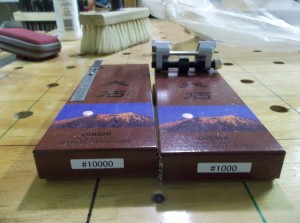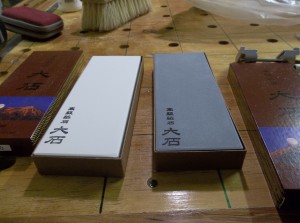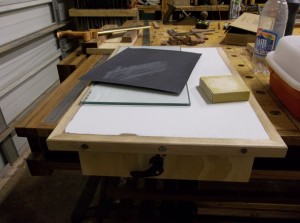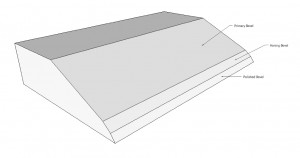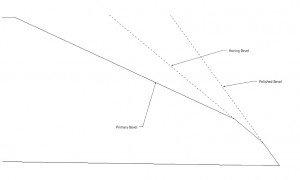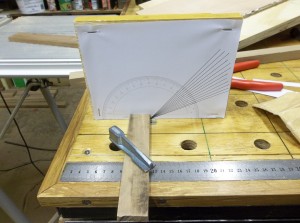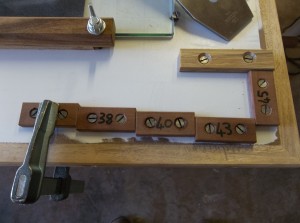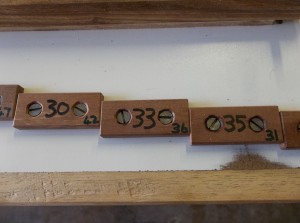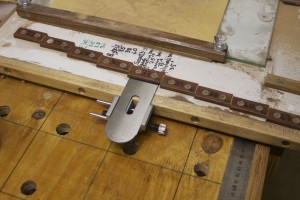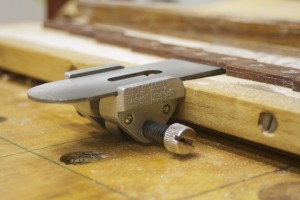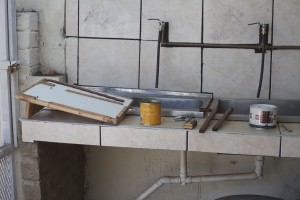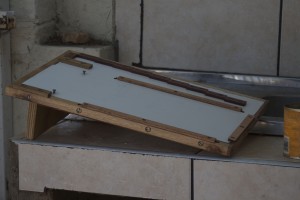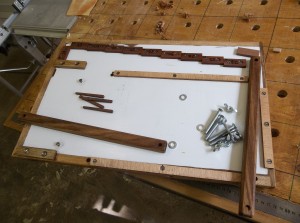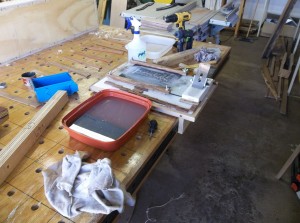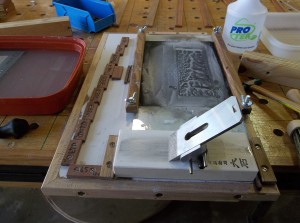I must say that I have to agree with all those experts (not that I am one of them) who say that hand tools become gratifying to work with when they are sharp. I heard and read this all over the show, which steered me towards a DVD on sharpening by David Charlesworth. The official title is “Plane Sharpening” and I got mine from Lie-Nielsen. This is highly recommended for anyone who likes cerebral woodworking and attention to detail. David is somewhat dry as most English gentlemen tend to be, but nonetheless a real icon to me.
To cut a long story short, after watching this DVD 5 or 6 times I decided to acquire all the merchandise needed to become a sharpening maestro. I bought everything from Lie-Nielsen and while it traveled for forty days and forty nights across the Atlantic, I researched the different jig-setups that could aid in my new found forte. You will probably think that I am biased (possibly because I am), but the setup that made most sense to me was Deneb Puchalski’s, which you can find on the Lie-Nielsen website in pdf format. (check out www.lie-nielsen.com/pdf/AngleSettingJig.pdf and www.lie-nielsen.com/pdf/Sharpening.pdf for more useful information)
In the picture below you can see where I started with the jig. When I made this sharpening jig, the best plywood I could find was something they call shudder board in these parts. It’s that nasty stuff they use to build boxes in order to cast concrete slabs. Since then I have heard of a guy who sells better stuff, but have not managed to see it yet. Anyway, the mentioned shudder board warps more often than Michael Jackson did in one of his music videos. Therefore I glued a layer of hardboard and a layer of 6 mm plywood to it. The hardboard has a hardwearing white layer that seems water resistant on it’s smooth surface.
In the picture below you can see two of the most crucial appurtenances when it comes to sharpening. These are Ohishi Japanese waterstones as available from Lie-Nielsen. The grey stone is a 1000 grid (excellent for honing) and the white stone a 10 000 grid stone (splendiferous for polishing). These work like a charm for me. In the picture on the right you can see the side clamping honing guide that is apparently a cheap rip-off the original Eclipse version.
I used some scrap Blackwood (grown in the South Africa for ages but originally from Oz) to frame the plywood after gluing some hardboard (also known as Masonite) to the working surface. You can also see the way I decided to fix the jig to the assembly table. I took advantage of the ease of using quick release levers modified slightly to slot into the T-channel on the side of the table. This speeds up the setting up of my sharpening station.
David Charlesworth and most of the other authorities use only water to fix the wet-and-dry sandpaper to the glass, but like most woodworkers I love an overkill. Therefore I decided to install two clamping cauls on the sides of the glass. These clamp down by means of wing-nuts on top of 6 mm plywood strips that sits flush with the glass. The glass area is meant to be used with sandpaper for the more aggressive grinding of primary bevels and regular flattening of waterstones. The Sketchup drawings explain what I mean with primary bevel on a blade.
Next, I moved on to setting up stops at various distances from the edge of the jig corresponding to all the different angles I need to hone/grind blades at. It creates totally repeatable angles for each blade, provided that you have a system to know which angle you used the previous time. I used the setup below to establish the different projection distances for each angle, creeping up by 2-3° at a time. The plane blade is set against the scrap of wood setup at 90° to the protractor at the correct projection distance for each angle and then transfered to the jig.
In the pictures below you can see how I installed the stopblocks at the various different distances from the edge. Each stop block has the angle it corresponds to noted in black and the actual distance from the edge in millimeters noted in green. In the end (so far, as I plan to add a few more steep angles once I manage to modify the honing guide) the jig sported stopblocks ranging in steps of 2-3° from 23-45°.
Next the hardwood were varnished to stop the worst of the water that is inevitable during sharpening activities.
In the next few pictures you can see how I write the angles of the various bevels (as explained earlier) for the different blades I sharpen on the jig for easy reference. A “bytel” is a chisel in Afrikaans.
In the final pictures you can see the final product as I am using it for now. Please note the area designated to holding the waterstones wedged in tight with two small hardwood wedges. Also the Tupperware® container were my priced Ohishi stones swim in permanently to keep them ready for action. You will also see the telltale slurry on the sandpaper revealing that I flattened the white stone immediately before use.


